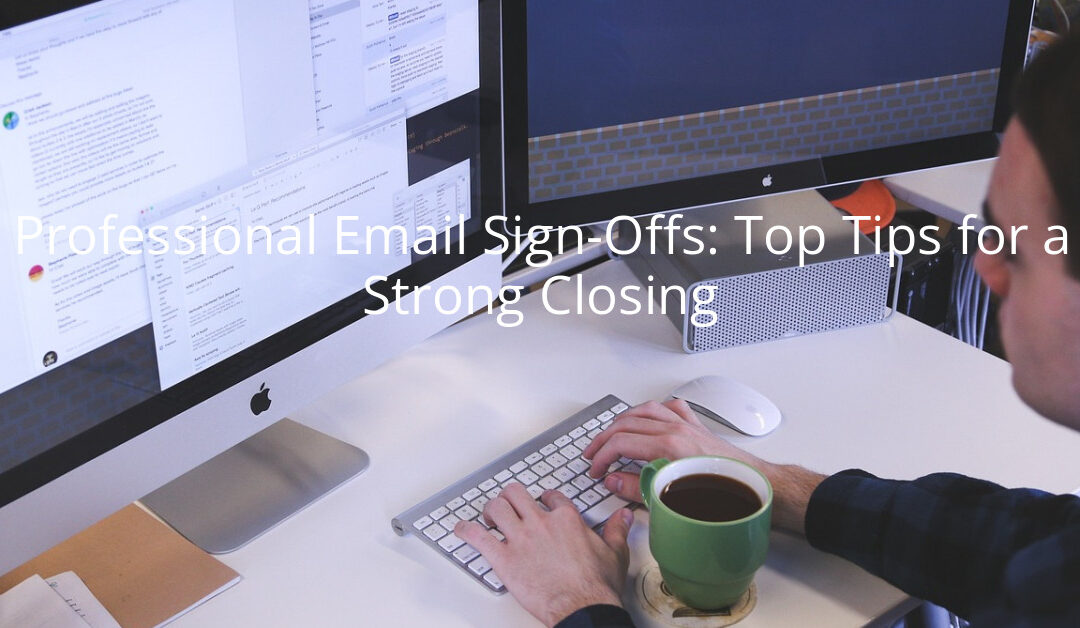 Ever feel that the end of an email is more intimidating than the start? How do you wrap up those crucial messages in a way that’s polished yet personable, confident yet courteous? For those navigating the fine line between professionalism and warmth, the email sign-off can feel like the finishing touch on a delicate piece of art.
Ever feel that the end of an email is more intimidating than the start? How do you wrap up those crucial messages in a way that’s polished yet personable, confident yet courteous? For those navigating the fine line between professionalism and warmth, the email sign-off can feel like the finishing touch on a delicate piece of art.
Closing an email isn’t just a matter of tossing out a quick “Best” or “Thanks.” With each message, you’re making an impression that can either strengthen your professional relationships or, in some cases, unravel the hard work put into the body of your email. Every word, down to the punctuation, can impact how your email is received, remembered, and responded to.
Whether you’re leading a team, engaging clients, or even applying for a role, here’s how to ensure your email endings resonate with respect, polish, and a touch of your unique style.
Related: Reach the Inbox Every Time: Top 7 Tips to Avoid Email Spam Filters
1. Classic Closures: Go-To Email Closing Salutations That Never Fail
 It’s often said that “less is more,” and this holds remarkably true with email sign-offs. Some of the most effective ways to end an email professionally involve classic closings, ones that don’t shout for attention but subtly express respect and reliability.
It’s often said that “less is more,” and this holds remarkably true with email sign-offs. Some of the most effective ways to end an email professionally involve classic closings, ones that don’t shout for attention but subtly express respect and reliability.
Popular choices include:
-
Best regards: A time-honored way to close emails that’s warm but businesslike.
-
Sincerely: This never goes out of style and is especially useful for more formal settings.
-
Regards: Brief, friendly, and to the point.
-
Kind regards: A slightly softer take on “Regards” that retains a professional tone.
These are your all-season favorites. Like a well-tailored blazer, they fit just about any context, leaving a favorable, no-fuss impression.
2. The Power Players: Polished Closings for More Personal Connections
 When you’re hoping to foster a stronger connection, a little bit of extra warmth can go a long way. Imagine, for a moment, that your email sign-off is like the firm, reassuring handshake at the end of a conversation—confident and memorable.
When you’re hoping to foster a stronger connection, a little bit of extra warmth can go a long way. Imagine, for a moment, that your email sign-off is like the firm, reassuring handshake at the end of a conversation—confident and memorable.
For those looking to add a touch of cordiality, consider:
-
Warm regards: Infuses the email with a touch of warmth, suggesting a friendly familiarity.
-
All the best: Often used by those hoping to leave a positive, supportive impression.
-
Many thanks: Perfect for when the recipient has helped or may help you with something important.
-
Take care: Friendly without losing professionalism, making it ideal for closing messages to known contacts.
These “power player” salutations can add subtle layers of personality without compromising professionalism. They give the impression of someone who is both capable and considerate—a winning combination in any professional setting.
3. Bringing It Home: Specific Closures for Unique Situations
 Like a well-played symphony, sometimes the situation demands a particular note. Closing email salutations can be tailored to the context, with variations that feel purposeful and genuinely fitting. When handling a request, collaboration, or follow-up, consider situational closings that show an extra degree of mindfulness.
Like a well-played symphony, sometimes the situation demands a particular note. Closing email salutations can be tailored to the context, with variations that feel purposeful and genuinely fitting. When handling a request, collaboration, or follow-up, consider situational closings that show an extra degree of mindfulness.
For instance:
-
Looking forward to your thoughts: Perfect when awaiting a response or input.
-
Thanks in advance: Works well for emails that request assistance.
-
Respectfully: Great for formal or hierarchical settings where deference is essential.
-
With appreciation: A grateful and slightly formal way to thank someone.
Each of these closures acknowledges the context of the email and leaves the recipient with a distinct feeling—they know you took the time to choose your words thoughtfully. That attention to detail? It’s a subtle yet impactful way to stand out.
4. Add a Personal Stamp: Incorporate Your Brand’s Voice
 Some industries or roles allow for a bit of creativity and wit—think marketing, media, or startups. While you should be cautious of overstepping professional boundaries, a little personality can make your emails feel more relatable and human.
Some industries or roles allow for a bit of creativity and wit—think marketing, media, or startups. While you should be cautious of overstepping professional boundaries, a little personality can make your emails feel more relatable and human.
If your role permits it, consider:
-
Stay inspired: Great for creative roles where encouragement is part of the process.
-
Onward and upward: A positive, forward-looking close that suggests energy and ambition.
-
Keep up the great work: Perfect for client-facing roles or project updates.
-
Cheers: Commonly used in British English, it conveys friendliness but can be tricky in more formal settings.
These are not for every occasion, but when used wisely, they can become a subtle signature that reflects who you are and what you stand for.
5. Punctuation Matters: The Power of a Well-Placed Period or Exclamation
 It might sound trivial, but punctuation can give your closing salutation an entirely different feel. A simple period at the end of “Thanks.” carries more weight than a “Thanks!” which could be perceived as overly familiar or casual in a formal exchange.
It might sound trivial, but punctuation can give your closing salutation an entirely different feel. A simple period at the end of “Thanks.” carries more weight than a “Thanks!” which could be perceived as overly familiar or casual in a formal exchange.
Similarly, exclamations like “Thank you!” or “Best regards!” can convey extra enthusiasm but may feel overly eager in a formal email. Match your punctuation to the context. Remember, an exclamation mark can light up a casual note but drown a professional one.
6. The Final Thought: A Meaningful Farewell
 Consider this your moment to leave a lasting impression. Beyond professional email sign-offs and polished wording, the tone of your email’s ending should mirror your broader goals and values. When chosen well, it’s a final opportunity to demonstrate your reliability, thoughtfulness, and approachability.
Consider this your moment to leave a lasting impression. Beyond professional email sign-offs and polished wording, the tone of your email’s ending should mirror your broader goals and values. When chosen well, it’s a final opportunity to demonstrate your reliability, thoughtfulness, and approachability.
Imagine your email as a handshake. A sign-off that’s genuinely yours not only closes your message but carries a bit of your personality, lingering just long enough to make the reader want to reach out to you again. Here, it’s not just the words themselves but the choice of words, the rhythm of the sentences, the subtle pauses. Email closings are the final brushstrokes on the canvas of communication. The words are yours—make them memorable.
Ready to Craft Exceptional Content?
In today’s competitive digital landscape, writing that resonates goes beyond choosing the right phrases. ContentERP is here to help you fine-tune your voice and elevate your communications, whether it’s through email, articles, or social media.
Sign up with ContentERP and discover content creation services designed to enhance your brand and empower your team. With our tools, writing isn’t just a task—it’s an art. Join today, and let’s write your success story together.
Related: Boost Visibility and Engagement with Strategic Internal Linking

